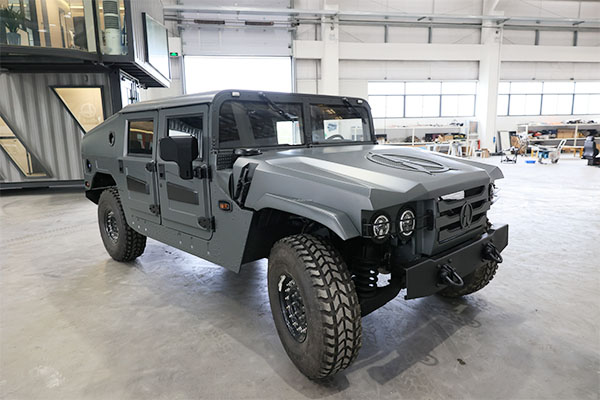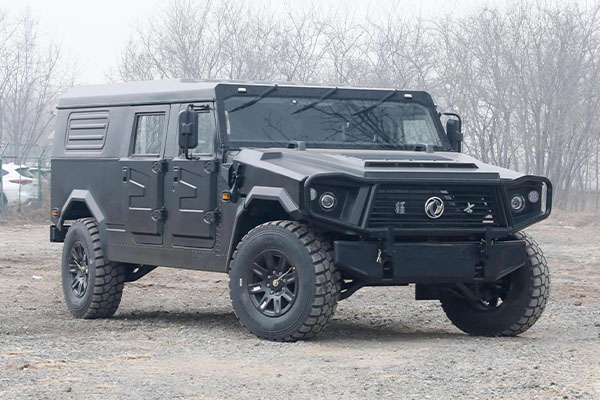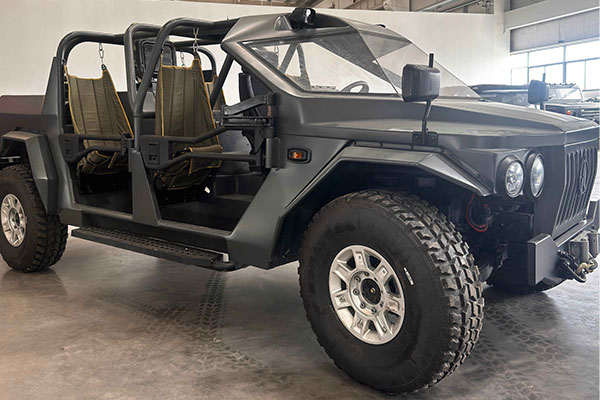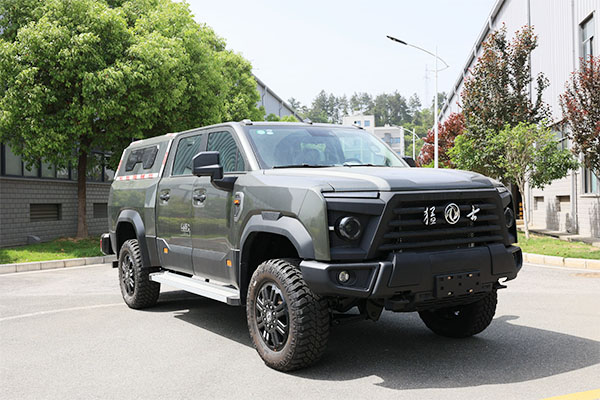How can high-performance all-terrain off-road vehicles achieve a dual breakthrough in off-road rigidity and optimized passenger space?
Release Time : 2025-10-10
With the growing popularity of extreme off-roading and long-distance trekking, high-performance all-terrain off-road vehicles are no longer simply tools for tackling rough terrain; they are now expected to offer comprehensive comfort, safety, and intelligent features. However, traditional off-road vehicles have long faced an irreconcilable contradiction: to ensure structural rigidity and load-bearing capacity in extreme road conditions, they often utilize a sturdy frame-type chassis and exposed suspension system, which inevitably encroaches on interior space and sacrifices ride comfort. Today, through comprehensive chassis structural upgrades, high-performance all-terrain off-road vehicles are successfully breaking through this constraint, achieving a dual breakthrough in off-road rigidity and optimized passenger space.
1. Reconstructing the Chassis Architecture: Redefining Rigidity and Space
The key to achieving this dual breakthrough lies in a systematic upgrade of the chassis structure. While traditional non-load-bearing bodies offer high torsional rigidity, they are also heavy, have a high center of gravity, and have low interior space utilization. While retaining the high strength of a ladder-frame frame, modern high-performance off-road vehicles utilize high-strength alloy steel and topological optimization. Computer simulations accurately distribute force paths, ensuring deformation resistance under extreme torsional conditions while significantly reducing frame weight and optimizing structural layout. This "slimming down, strengthening" design facilitates a forward cabin position, a flat floor, and retracted wheel arches, significantly expanding front and rear headroom, legroom, and lateral space without increasing overall vehicle size.
2. Front Suspension Innovation: The Precision and Freedom of Double Wishbone Independent Suspension
The adoption of a double wishbone independent suspension on the front axle is a key step in improving handling and space utilization. Compared to traditional integral axle structures, double wishbone suspension allows for independent wheel movement on bumpy roads, significantly improving roadholding and driving stability. More importantly, its compact design reduces intrusion from the front wheel arches into the cabin, enabling more flexible steering system layout and placing the steering wheel closer to the driver, optimizing ergonomics. At the same time, the independent suspension reduces impact vibration transmitted to the vehicle body. Combined with high-performance shock absorbers, it ensures stability and comfort even when traversing gravel roads at high speeds, effectively alleviating fatigue during long-distance driving.
3. Rear Axle Enhancement: Revolutionary Load-Carrying and Road-Travel Performance of Portal Leaf Springs
The portal leaf spring structure in the rear axle is a strategic choice that balances off-road load capacity and ground clearance. Portal axle technology places the reducer at the wheel hub, allowing the driveshaft to rise significantly above the wheel center, significantly increasing ground clearance without increasing vehicle height. This is crucial for navigating obstacles such as rocks and deep trenches. Leaf springs, as a traditional off-road rear suspension, offer the advantages of a simple structure, high load capacity, and resistance to harsh environments. By optimizing the number of leaves, curvature, and bushing material, modern leaf springs significantly improve ride smoothness while maintaining high load capacity. This "rigid and flexible" rear suspension design ensures the vehicle remains stable and reliable even when fully loaded with equipment and traversing uninhabited areas.
4. Synergistic Optimization of Space and Environment
The upgrade of the chassis structure directly frees up freedom in cabin design. A flat floor and low entry threshold facilitate easy entry and exit. A higher roofline and steeper A-pillar angle enhance passenger space and visibility while maintaining structural strength. The optimized driving environment extends beyond the physical dimensions. Ergonomic seats, noise-reducing insulation, an intelligent climate control system, and a digital instrument cluster ensure the driver remains focused and comfortable even in challenging terrain.
This high-performance all-terrain off-road vehicle, through an upgraded chassis structure, transforms "toughness" and "comfort" from opposing concepts into mutually beneficial ones. The front double-wishbone independent suspension enhances handling and cabin space, while rear-door leaf springs ensure load-carrying and maneuverability. Combined with a lightweight, high-strength frame and user-friendly cabin design, the vehicle achieves breakthroughs in both off-road toughness and passenger space.
1. Reconstructing the Chassis Architecture: Redefining Rigidity and Space
The key to achieving this dual breakthrough lies in a systematic upgrade of the chassis structure. While traditional non-load-bearing bodies offer high torsional rigidity, they are also heavy, have a high center of gravity, and have low interior space utilization. While retaining the high strength of a ladder-frame frame, modern high-performance off-road vehicles utilize high-strength alloy steel and topological optimization. Computer simulations accurately distribute force paths, ensuring deformation resistance under extreme torsional conditions while significantly reducing frame weight and optimizing structural layout. This "slimming down, strengthening" design facilitates a forward cabin position, a flat floor, and retracted wheel arches, significantly expanding front and rear headroom, legroom, and lateral space without increasing overall vehicle size.
2. Front Suspension Innovation: The Precision and Freedom of Double Wishbone Independent Suspension
The adoption of a double wishbone independent suspension on the front axle is a key step in improving handling and space utilization. Compared to traditional integral axle structures, double wishbone suspension allows for independent wheel movement on bumpy roads, significantly improving roadholding and driving stability. More importantly, its compact design reduces intrusion from the front wheel arches into the cabin, enabling more flexible steering system layout and placing the steering wheel closer to the driver, optimizing ergonomics. At the same time, the independent suspension reduces impact vibration transmitted to the vehicle body. Combined with high-performance shock absorbers, it ensures stability and comfort even when traversing gravel roads at high speeds, effectively alleviating fatigue during long-distance driving.
3. Rear Axle Enhancement: Revolutionary Load-Carrying and Road-Travel Performance of Portal Leaf Springs
The portal leaf spring structure in the rear axle is a strategic choice that balances off-road load capacity and ground clearance. Portal axle technology places the reducer at the wheel hub, allowing the driveshaft to rise significantly above the wheel center, significantly increasing ground clearance without increasing vehicle height. This is crucial for navigating obstacles such as rocks and deep trenches. Leaf springs, as a traditional off-road rear suspension, offer the advantages of a simple structure, high load capacity, and resistance to harsh environments. By optimizing the number of leaves, curvature, and bushing material, modern leaf springs significantly improve ride smoothness while maintaining high load capacity. This "rigid and flexible" rear suspension design ensures the vehicle remains stable and reliable even when fully loaded with equipment and traversing uninhabited areas.
4. Synergistic Optimization of Space and Environment
The upgrade of the chassis structure directly frees up freedom in cabin design. A flat floor and low entry threshold facilitate easy entry and exit. A higher roofline and steeper A-pillar angle enhance passenger space and visibility while maintaining structural strength. The optimized driving environment extends beyond the physical dimensions. Ergonomic seats, noise-reducing insulation, an intelligent climate control system, and a digital instrument cluster ensure the driver remains focused and comfortable even in challenging terrain.
This high-performance all-terrain off-road vehicle, through an upgraded chassis structure, transforms "toughness" and "comfort" from opposing concepts into mutually beneficial ones. The front double-wishbone independent suspension enhances handling and cabin space, while rear-door leaf springs ensure load-carrying and maneuverability. Combined with a lightweight, high-strength frame and user-friendly cabin design, the vehicle achieves breakthroughs in both off-road toughness and passenger space.







